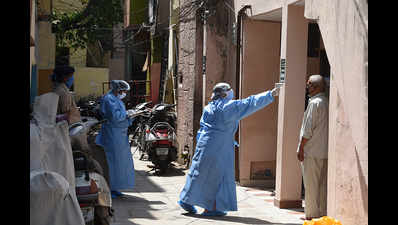- News
- City News
- chandigarh News
- PGI-Chandigarh study: Coronavirus doesn’t transmit through food, water
Trending
This story is from July 17, 2020
PGI-Chandigarh study: Coronavirus doesn’t transmit through food, water
The PGI doctors who have studied coronavirus infer that it can’t transmit through food or water contaminated with the faecal matter of an infected patient. Besides respiratory effects, the virus also has gastrointestinal (GI) symptoms.

Once people understand how the virus spreads, they'll be less afraid of it
CHANDIGARH: The PGI doctors who have studied coronavirus infer that it can’t transmit through food or water contaminated with the faecal matter of an infected patient. Besides respiratory effects, the virus also has gastrointestinal (GI) symptoms.
 Dr Rakesh Kochhar, corresponding author of the study published in the Journal of Digestive Endoscopy, said: “Going by the available medical literature we reviewed, the virus can be detected with RT-PCR (reverse transcription polymerase chain reaction) test and can remain in the stool for two to four weeks.It appears even in the throats of cured people. However, during infectivity tests, it is not found after 10 days of infection.”
Dr Rakesh Kochhar, corresponding author of the study published in the Journal of Digestive Endoscopy, said: “Going by the available medical literature we reviewed, the virus can be detected with RT-PCR (reverse transcription polymerase chain reaction) test and can remain in the stool for two to four weeks.It appears even in the throats of cured people. However, during infectivity tests, it is not found after 10 days of infection.”
GI manifestations of Covid-19 (abdominal pain, diarrhoea, vomiting, loss of taste) are being reported more frequently with time. Dr Kochhar said: “The RT-PCR is a very sensitive test, since it multiplies the virus. Thus, even some strands of the infection-free RNA can also be picked up as positive for the virus. This is concerning only if they have a high viral load (the ability to infect). No sewerage treatment is required, thus, when the virus flushes out of the water.”
The study done at the Post Graduate Institute of Medical Education and Research mentions that the digestive system of the patients is affected both by Covid-19 and the drugs given to treat the virus. Recently, there were reports of the outbreak in close settings such as restaurants, night clubs, and places of worship. These places had poor ventilation and asymptomatic people spent more time in the closed area.
The World Health Organisation (WHO) says more studies are required to investigate the modes of transmission of this virus.

GI manifestations of Covid-19 (abdominal pain, diarrhoea, vomiting, loss of taste) are being reported more frequently with time. Dr Kochhar said: “The RT-PCR is a very sensitive test, since it multiplies the virus. Thus, even some strands of the infection-free RNA can also be picked up as positive for the virus. This is concerning only if they have a high viral load (the ability to infect). No sewerage treatment is required, thus, when the virus flushes out of the water.”
The study done at the Post Graduate Institute of Medical Education and Research mentions that the digestive system of the patients is affected both by Covid-19 and the drugs given to treat the virus. Recently, there were reports of the outbreak in close settings such as restaurants, night clubs, and places of worship. These places had poor ventilation and asymptomatic people spent more time in the closed area.
The World Health Organisation (WHO) says more studies are required to investigate the modes of transmission of this virus.
End of Article
FOLLOW US ON SOCIAL MEDIA










